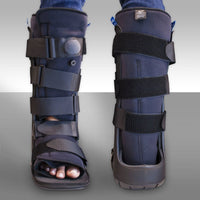Description
Peroneal tendon subluxation occurs following an injury to the peroneal retinaculum. The peroneal retinaculum is a small, fibrous band that acts to restrain the peroneal tendons in a deep groove on the back of the fibula. The peroneal retinaculum is often injured in a lateral ankle sprain. Other causes of subluxation include anatomical variations of the fibular groove that may make the groove shallow and less able to inhibit the peroneal tendons from subluxation during ankle motion.
The peroneus brevis muscle originates from the upper two-thirds of the fibula. It inserts into the base of the 5th metatarsal on the lateral side of the foot. The peroneus longus muscle originates from the tibia, fibula, and the inter-muscular septum. The tendon of the peroneus longus muscle travels parallel to the peroneus brevis tendon and posterior to it in a position "behind" the brevis as the two tendons descend and change direction at the distal tip of the fibula. The tendon continues to the lateral aspect of the foot, where it abruptly turns and travels across the plantar aspect of the foot to insert into the first metatarsal base and medial cuneiform. The function of the peroneal tendons is to evert the foot and plantarflex the ankle. In addition to these functions, the peroneus longus tendon also helps to stabilize the arch and acts to stabilize the foot during weight bearing.
Causes and contributing factors
 Lateral ankle instability and injuries to the lateral ankle ligaments make the ankle weak and susceptible to recurrent ankle sprains. Recurrent ankle sprains lead to damage to the peroneal retinaculum, making the ankle more prone to peroneal tendon subluxation. When considering surgical repair of peroneal tendon subluxation, surgical repair of lateral ankle instability is necessary to prevent further damage to the peroneal retinaculum.
Lateral ankle instability and injuries to the lateral ankle ligaments make the ankle weak and susceptible to recurrent ankle sprains. Recurrent ankle sprains lead to damage to the peroneal retinaculum, making the ankle more prone to peroneal tendon subluxation. When considering surgical repair of peroneal tendon subluxation, surgical repair of lateral ankle instability is necessary to prevent further damage to the peroneal retinaculum.
Uncompensated rearfoot varus is a structural deformity of the heel. Rearfoot varus is an often overlooked contributing factor in recurrent lateral ankle sprains. Uncompensated rearfoot varus is another biomechanical issue that is often corrected in conjunction with correction of peroneal tendon subluxation. Correction of uncompensated rearfoot varus is accomplished by a Dwyer osteotomy of the heel or calcaneal slide osteotomy.
Differential diagnosis
The differential diagnosis of peroneal tendon subluxation includes:
Ankle fracture
Ankle sprain
Peroneal tendinitis
Peroneal tendon rupture
Treatment
A period of conservative care should be observed following an acute injury to the peroneal tendons. A walking cast, ice, and a compression wrap may help to enable healing of the peroneal retinaculum. A lateral sole wedge can be used to decrease load to the peroneal tendons. Lateral sole wedges can be placed in the shoe, on specialized orthotics or applied to the outer sole of the shoe by a shoe repair shop or O&P facility. 
In cases of chronic peroneal tendon subluxation, surgical repair will be required to prevent subluxation and long-term damage to the peroneal tendons. Treatment of peroneal tendon subluxation involves deepening the peroneal groove of the fibula and repair of the peroneal retinaculum. A number of different methods have been described in the surgical literature that are used to add depth to the peroneal groove, thereby limiting peroneal tendon subluxation. Those methods include drilling, tamping, and creating rotating osseous (bone) shelves. Repair of the peroneal retinaculum may be accomplished by direct suture repair or by a supplemental graft from the Achilles tendon.
When planning surgical repair of recurrent peroneal tendon subluxation, it's important to remember to treat any biomechanical factors that may contribute to lateral instability and ankle sprains. It's important to recognize that these biomechanical factors may be the contributing causes of the peroneal tendon subluxation in the first place. If these biomechanical co-morbidities are not addressed, surgical repair of peroneal subluxation may be doomed to failure. Three common biomechanical faults found in conjunction with peroneal tendon subluxation include lateral ankle ligament instability, uncompensated rearfoot varus, and uncompensated forefoot valgus.
Lateral ankle ligament instability and ligament tears contribute to ankle instability and recurrent ankle sprains. If ligament laxity is not addressed and lateral ankle sprains continue, surgery to correct peroneal tendon subluxation is likely to fail. It is not unusual to perform a Brostrom lateral ankle stabilization in conjunction with a repair of peroneal tendon subluxation.
When to contact your doctor
Recurrent subluxation of the peroneal tendons can lead to tendon damage. Subluxation should be addressed to prevent further damage to the tendons. Consult your podiatrist or orthopedist for additional recommendations.
References
References are pending.
Author(s) and date
 This article was written by Myfootshop.com medical advisor Jeffrey A. Oster, DPM.
This article was written by Myfootshop.com medical advisor Jeffrey A. Oster, DPM.
Competing Interests - None
Cite this article as: Oster, Jeffrey. Peroneal Tendon Subluxation. /blogs/articles/peroneal-tendon-subluxation
Most recent article update: January 14, 2021.
 Peroneal Tendon Subluxation by Myfootshop.com is licensed under a Creative Commons Attribution-NonCommercial 3.0 Unported License.
Peroneal Tendon Subluxation by Myfootshop.com is licensed under a Creative Commons Attribution-NonCommercial 3.0 Unported License.
Internal reference only: ZoneL3









